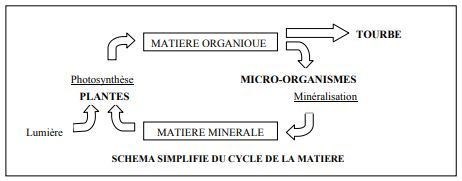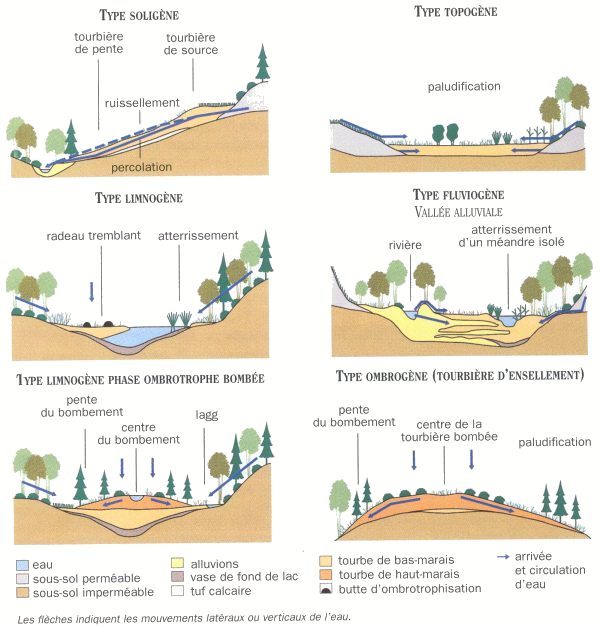
Cette cache peut ne pas être accessible l'hiver
This cache may not be accessible at winter season

click on the flag to reach the translation

Une Earthcache
Il ne s’agit pas d’une cache physique. Pour loguer cette cache, vous devez dans un premier temps prendre connaissance de sa description éducative en matière de géologie, puis d’observer le site sur lequel vous êtes, et enfin de répondre aux questions qui vous seront posées.
Vous pourrez alors loguer en "Found it" sans attendre mais vous devez me faire parvenir vos réponses en même temps en me contactant soit par mail dans mon profil, soit via la messagerie geocaching.com (Message Center), et je vous contacterai en cas de problème. Les logs enregistrés sans réponses seront supprimés.

Un peu de géologie
> La tourbe
La tourbe est une sorte de roche constituée par l’accumulation de débris végétaux qui se sont très peu décomposés et ne se dégradent pas du fait de l'engorgement total et permanent du sol. Les conditions qui règnent dans une tourbière rendent la phase de minéralisation impossible. En effet, la présence permanente de l’eau, sa pauvreté en oxygène, les températures basses empêchent l’activité des micro-organismes qui transforment habituellement la matière organique en matière minérale.
Cela rompt le cycle naturel de minéralisation du sol, pour former un horizon purement organique.

La tourbification nécessite un double bilan positif.
- L'alimentation en eau est supérieure à l'évapotranspiration du tapis végétal : les conditions hydriques favorisent certaines espèces hygrophiles.
- La vitesse de production de la matière organique est supérieure à sa vitesse de décomposition : les conditions anaérobies favorisent l'accumulation des restes végétaux.
Dans ces conditions, la matière organique s’accumule et forme de la tourbe.
Crédits: fafahakkai
> Différents types de tourbière
Il existe plusieurs classifications permettant d’identifier et de décrire les tourbières, qui font référence à certains de leurs caractères. Ainsi, parmi ceux généralement retenus, les influences climatiques et biogéographiques permettent de distinguer, selon leur répartition, des tourbières boréales, atlantiques, continentales, méditerranéennes, tropicales ou équatoriales...
La classification la plus intéressante aujourd’hui tient compte à la fois de l’origine (termes en -"gène") et du mode d’alimentation hydrique (termes en -"trophe") des tourbières.
Lorsque les conditions d’un bilan hydrique positif sont réunies, associées à une production de matière organique excédentaire, les processus de turbification pourront s’amorcer et donner naissance à différents types de tourbières en fonction des conditions de leur formation.

- Les tourbières topogènes résultent de l’accumulation des eaux, provenant de ruissellements ou d’une nappe affleurante, dans une dépression topographique.
- Les tourbières limnogènes sont issues de l’atterrissement progressif d’une pièce d’eau à partir de radeaux végétaux flottants.
- Les tourbières soligènes naissent à la faveur d’un écoulement lent et continu le long d’une faible pente (sources, suintements).
- Les tourbières fluviogènes (ou telmatogènes) proviennent de l’inondation périodique d’une vallée par un cours d’eau ou une nappe alluviale.
- Les tourbières ombrogènes, enfin, naissent lorsque les précipitations, abondantes, constituent la seule source hydrique responsable de la turbification.
- Deux autres types de tourbières peuvent être cités, bien que marginaux en France : les tourbières thalassogènes qui naissent au contact entre des eaux douces et des eaux marines (pannes dunaires et tourbières de transgression marine) et les tourbières condensarogènes issues de la condensation atmosphérique, notamment dans certains éboulis rocheux d’altitude.
Quel que soit leur mode de genèse, les tourbières pourront être de type minérotrophe (ou géotrophe) ou de type ombrotrophe, en fonction de leur mode d’alimentation hydrique.
- Dans le cas d’une alimentation minérotrophique, les eaux proviennent d’écoulements latéraux et ont été en contact avec le substratum géologique. Au contact du sol, ces eaux se sont généralement enrichies en substances minérales dissoutes, dans des proportions variables dépendant de la nature du substratum. Aussi, les tourbières minérotrophes sont très variées, acides à alcalines, oligotrophes à eutrophes. On les nomme bas-marais, tourbières basses ou tourbières plates ("fens" en anglais) car leur surface est généralement très proche de celle de leur nappe d’alimentation.
- Les tourbières ombrotrophes, que l’on rencontre sous des climats très pluvieux, ne sont, quant à elles, alimentées que par les eaux météoriques (pluie, neige, brouillard), acides et pauvres en ions minéraux. Elles donnent alors naissance à des tourbières toujours acides et oligotrophes, dominées par les sphaignes et appelées hauts-marais, tourbières hautes ou tourbières bombées ("bogs" en anglais) en raison de la forme de dôme généralement prise par leur surface.
Source: www.pole-tourbieres.org

Questions
Question 0 - Prenez une photo de vous, ou de votre objet distinctif de géocacheur, ou de votre pseudo écrit sur une feuille de papier ou dans votre main... au niveau du pont, et joignez-là à votre log ou à vos réponses
Zone d'observation - Nous allons ici observer uniquement une zone unique au niveau de la tourbière
Question 1 - Quelles sont les 2 conditions positives nécessaires pour la formation une tourbière

Question 2 - Prenez un bâton, une branche morte ou tout autre objet. Restez sur le ponton ! Sondez de part et d'autre du ponton, aux WP1 et WP2. A quel waypoint observez-vous la tourbière ?
Question 3 - Quelle est la classification de cette tourbière en considérant son origine de formation (mot en -gène), expliquez votre réponse par l'observation du terrain ?
Question 4 - Cette tourbière est-elle minérotrophe ou ombrotrophe ?


An Earthcache
It is not a physical cache. To log this cache, you must first learn about its educational description in geology, then observe the site on which you are, and finally answer the questions that will be asked.
You can then log in "Found it" without waiting but you must send me your answers at the same time by contacting me either by mail in my profile, or via the messaging geocaching.com (Message Center), and I will contact you in case of problem. Saved logs without answers will be deleted.

A little of geology
> Peat
Peat is a kind of rock formed by the accumulation of plant debris that has decomposed very little and does not degrade due to total and permanent waterlogging of the soil. The conditions in a peat bog make the mineralization phase impossible. Indeed, the permanent presence of water, its lack of oxygen, low temperatures prevent the activity of microorganisms that usually transform organic matter into mineral matter.
This breaks the natural cycle of soil mineralization, forming a purely organic horizon.

Peatification requires a double positive assessment.
- The water supply is greater than the evapotranspiration of the plant cover: the water conditions favor certain hygrophilic species.
- The rate of production of organic matter is greater than its rate of decomposition: anaerobic conditions favor the accumulation of plant remains.
Under these conditions, organic matter accumulates and forms peat.
Credits: fafahakkai
> Different types of bog
There are several classifications for identifying and describing peatlands, which refer to some of their characteristics. Thus, among those generally retained, climatic and biogeographical influences make it possible to distinguish, according to their distribution, boreal, Atlantic, continental, Mediterranean, tropical or equatorial peatlands ...
The most interesting classification today takes into account both the origin (terms in - "genic") and the mode of water supply (terms in - "trophic") of peatlands.
When the conditions for a positive water balance are met, associated with the production of excess organic matter, turbification processes can begin and give rise to different types of peatlands depending on the conditions of their formation. </ p>

- Topogenic peatlands result from the accumulation of water, from runoff or from an outcrop, in a topographic depression.
- Limnogenic peatlands arise from the gradual landing of a piece of water from floating vegetative rafts.
- Solid peatlands arise from a slow and continuous flow along a gentle slope (springs, seeps).
- Fluviogenic (or telmatogenic) peatlands originate from the periodic flooding of a valley by a stream or an alluvial sheet.
- Finally, ombrogenic peatlands arise when abundant precipitation is the only water source responsible for turbification.
- Two other types of peatlands can be cited, although marginal in France: thalassogenic peatlands which arise from contact between fresh water and marine water (dune purlins and marine transgression peatlands) and condensarogenic peatlands resulting from condensation atmospheric, especially in certain high-altitude rocky scree.
Whatever their method of genesis, peatlands can be of the minerotrophic (or geotrophic) or ombrotrophic type, depending on their water supply mode.
- In the case of a minerotrophic supply, the waters originate from lateral flows and have been in contact with the geological bedrock. In contact with the ground, these waters are generally enriched in dissolved mineral substances, in variable proportions depending on the nature of the substratum. Also, minerotrophic peatlands are very varied, acidic to alkaline, oligotrophic to eutrophic. They are called swamps, low peat bogs or flat peat bogs ("fens" in English) because their surface is generally very close to that of their water table.
- Ombrotrophic peatlands, which are found in very rainy climates, are only fed by meteoric water (rain, snow, fog), which is acidic and poor in mineral ions. They then give rise to bogs that are always acidic and oligotrophic, dominated by sphagnum mosses and called high marshes, high bogs or rounded bogs ("bogs" in English) because of the dome shape generally taken by their surface. </ Li >
Source: www.pole-tourbieres.org

Questions
Question 0 - Take a picture of yourself, or your geocacher feature, or your nickname written on a piece of paper or in your hand ... around the bridge, and attach it to your log or your answers
Observation zone - Here we will only observe a single area at the level of the bog
Question 1 - What are the 2 positive conditions necessary for the formation of a peat bog

Question 2 - Take a stick, a dead branch, or any other object. Stay on the pontoon! Probe on either side of the pontoon, at WP1 and WP2. At which waypoint do you observe the bog?
Question 3 - What is the classification of this peat bog considering its origin of formation (word in -gene), explain your answer by observing the ground?
Question 4 - Is this bog minerotrophic or ombrotrophic?